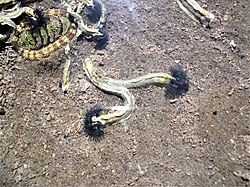Biology:Spirobranchus cariniferus
| Blue tubeworm | |
|---|---|

| |
| Scientific classification | |
| Domain: | Eukaryota |
| Kingdom: | Animalia |
| Phylum: | Annelida |
| Clade: | Pleistoannelida |
| Subclass: | Sedentaria |
| Order: | Sabellida |
| Family: | Serpulidae |
| Genus: | Spirobranchus |
| Species: | S. cariniferus
|
| Binomial name | |
| Spirobranchus cariniferus Gray, 1843
| |
Spirobranchus cariniferus, commonly known as the blue tubeworm or spiny tubeworm, or by its Māori name toke pā, is a species of tube-building polychaete worm endemic to New Zealand.[1][2][3]
This species forms patchy, belt-like colonies of hard, white, triangular tubes, each containing a bright blue worm. These are cemented to the shaded side of rocks in the lower to mid-tidal zone. It may also inhabit hard objects such as dead shells and small stones. When submerged, it puts out a fan of dark-blue tentacles to feed, which it retracts during low tide.[1][2][4]
Individuals living in Dunedin's Otago Harbour are the only polychaetes known to host gregarine parasites. Little is known about their impact on the worms, but it is likely to be a negative one.[5]
Description
Adult worms can grow to 40 mm long and 3 mm wide.[2] The tube is hard, white, and triangular in cross-section with a ridge running along the top. This extends from above the tube opening to form a sharp protective spine. The operculum is a flat, calcareous plate. Its stalk is flat with prolonged wings.[1][2] Its body is a yellow to orange colour towards the posterior and a bright blue at the anterior. Radioles are a bright to dark blue with some white bands. [2]
Diet
The blue tubeworm is a surface filter feeder. It feeds on plankton and organic particles, which it filters from the water using its fan of tentacles.[1][6][7]
Distribution
It is found throughout New Zealand.[1] Its tube layers can be up to 30 cm thick in the cooler climate of the South Island.[2]
References
- ↑ Jump up to: 1.0 1.1 1.2 1.3 1.4 Carson, Sally; Morris, Rod (2017) (in en). Collins Field Guide to the New Zealand Seashore. Auckland: HarperCollins Publishers New Zealand. ISBN 978-1775540106.
- ↑ Jump up to: 2.0 2.1 2.2 2.3 2.4 2.5 "Spirobranchus cariniferus (Gray, 1843)". http://www.annelida.net/nz/Polychaeta/Family/Serpulidae/spirobranchus-cariniferus.htm.
- ↑ "WoRMS - World Register of Marine Species - Spirobranchus cariniferus (Gray, 1843)" (in en). http://www.marinespecies.org/aphia.php?p=taxdetails&id=369294.
- ↑ Smith, AM; Henderson, ZE; Kennedy, M; King, TM; Spencer, HG (2012-06-26). "Reef formation versus solitariness in two New Zealand serpulids does not involve cryptic species" (in en). Aquatic Biology 16 (1): 97–103. doi:10.3354/ab00444. ISSN 1864-7782. https://www.int-res.com/abstracts/ab/v16/n1/p97-103/.
- ↑ Poulin, R.; Randhawa, H. S.; Peoples, R. C. (2012). "Parasites of polychaetes and their impact on host survival in Otago Harbour, New Zealand" (in en). Journal of the Marine Biological Association of the United Kingdom 92 (3): 449–455. doi:10.1017/S0025315411000774. ISSN 1469-7769. https://www.cambridge.org/core/journals/journal-of-the-marine-biological-association-of-the-united-kingdom/article/parasites-of-polychaetes-and-their-impact-on-host-survival-in-otago-harbour-new-zealand/06DFC2B996936D25D3CA5A0D6E8A4FB8.
- ↑ "Worm, Blue Tube". http://www.marinelife.ac.nz/species/1024.
- ↑ Taonga, New Zealand Ministry for Culture and Heritage Te Manatu. "3. – Marine animals without backbones – Te Ara Encyclopedia of New Zealand" (in en). https://teara.govt.nz/en/marine-animals-without-backbones.
Wikidata ☰ Q2517079 entry
 |

